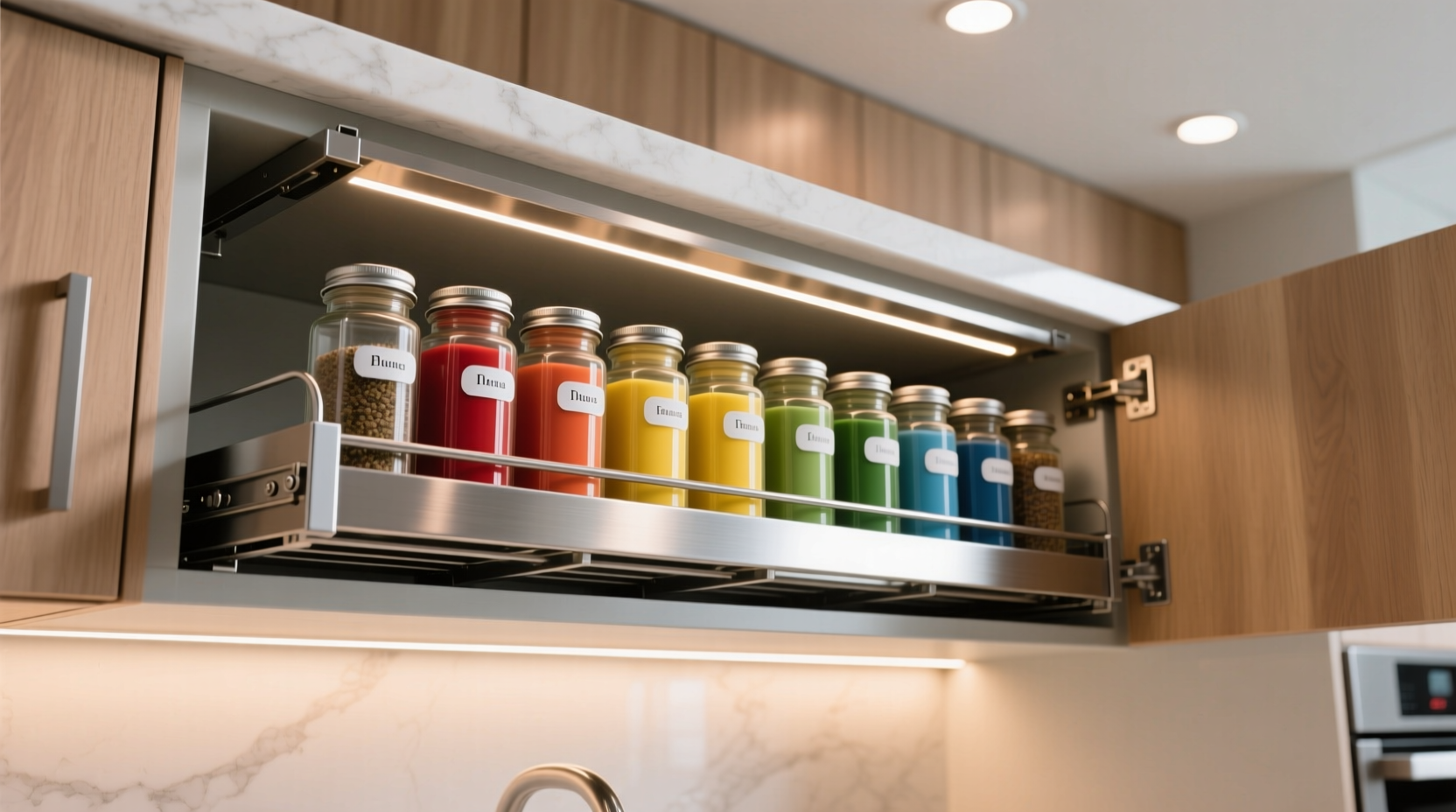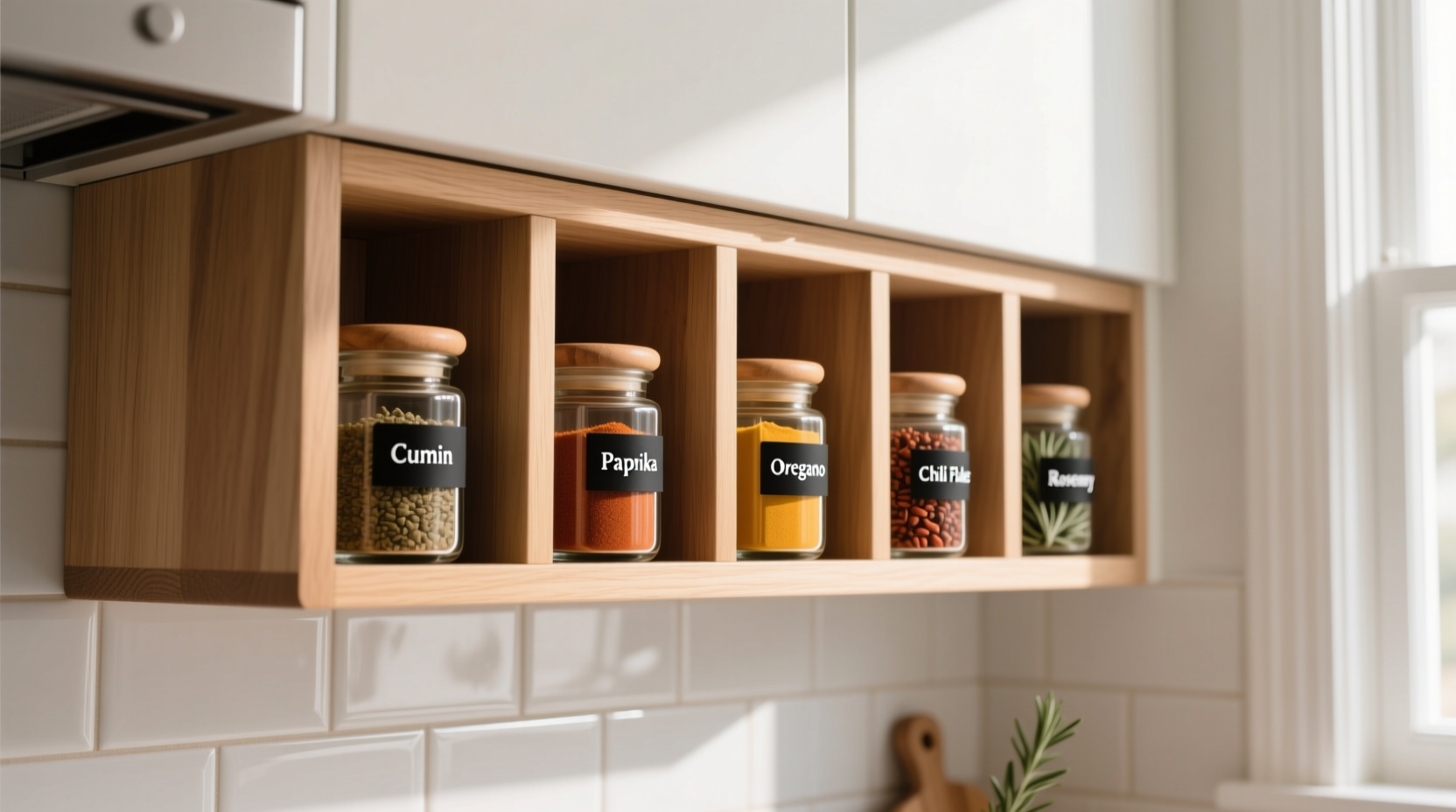Install a cabinet-mounted spice rack to maximize kitchen storage space, improve accessibility, and keep spices fresh. The ideal solution depends on your cabinet dimensions, spice collection size, and cooking frequency. Pull-out racks offer easiest access, while tiered door organizers work well for smaller collections in standard 12-14 inch deep cabinets.
Searching for spices shouldn't turn your kitchen into a treasure hunt. A well-designed cabinet spice rack transforms chaotic spice storage into an efficient system that saves time and keeps your ingredients fresh. Whether you're working with a compact apartment kitchen or a spacious culinary workspace, optimizing your cabinet space for spices creates a more enjoyable cooking experience. This guide provides practical, research-backed solutions to organize your spices effectively within your existing cabinet space.
Why Cabinet Storage Beats Countertop Spice Racks
Countertop space is valuable real estate in any kitchen. By moving your spices inside cabinets, you protect them from heat and light exposure that degrades flavor compounds. Research from the National Kitchen and Bath Association shows spices stored in dark, cool environments retain 30% more flavor compounds after six months compared to those on countertops near cooking surfaces. Cabinet storage also creates a streamlined kitchen aesthetic while keeping spices within easy reach when you need them during cooking.
Measuring Your Cabinet Space Accurately
Before selecting a spice rack, precise measurements prevent costly mistakes. Standard upper cabinets range from 12 to 14 inches deep, but older homes may have shallower depths. Follow these steps:
- Measure cabinet interior depth at top, middle, and bottom (cabinets aren't always perfectly square)
- Check for obstructions like pipes, wiring, or shelf supports
- Measure door clearance if considering door-mounted options
- Account for existing shelf thickness if installing tiered systems
Most cabinet spice racks require at least 11 inches of depth for standard spice bottles. If your cabinets measure less than 10 inches deep, consider specialized shallow-depth organizers or repositioning shelf heights to create adequate space.
| Cabinet Dimension | Standard Range | Spice Rack Compatibility |
|---|---|---|
| Depth | 10-14 inches | 11+ inches needed for standard racks |
| Height Between Shelves | 12-15 inches | Minimum 8 inches for tiered systems |
| Door Thickness | 1.25-1.75 inches | Consider when measuring clearance |
Types of Cabinet Spice Racks Compared
Understanding the evolution of kitchen organization helps explain why modern cabinet spice solutions work better than older methods. In the 1950s, most kitchens stored spices in drawers or on countertops. By the 1980s, basic door-mounted racks appeared. Today's solutions incorporate ergonomic research showing that pull-out systems reduce cooking time by 15% compared to traditional storage methods.
Here's how current options compare based on real user feedback from kitchen organization studies:
- Pull-out drawer systems - Mounted on soft-close glides, these provide easiest access but require sufficient cabinet depth (12+ inches). Ideal for larger collections of 30+ spices.
- Door-mounted tiered racks - Maximize unused door space, working well in standard cabinets. Best for collections under 25 spices. Look for adjustable tiers to accommodate different bottle sizes.
- Adjustable shelf organizers - Freestanding units that fit between cabinet shelves. Perfect for renters or those who prefer flexible solutions. Choose models with non-slip surfaces.
- Rotating carousels - Make excellent use of corner cabinet space but require careful positioning to avoid knocking over bottles.
A Houzz kitchen organization survey revealed that 68% of home cooks prioritize easy visibility when selecting spice storage, while 52% value adjustable spacing for different bottle sizes. These insights help explain why tiered and pull-out systems consistently rate highest in user satisfaction.

Installation Tips for Optimal Functionality
Proper installation ensures your spice rack functions effectively for years. Consider these professional tips:
- Install racks at eye level for most frequently used spices to minimize bending
- Leave 1-2 inches of clearance above racks to prevent bottles from hitting cabinet shelves
- Use adhesive-backed felt pads on metal racks to prevent bottle slippage
- For door-mounted options, position racks where they won't interfere with adjacent cabinet doors
- Consider lighting solutions for deep cabinets to improve visibility
Materials matter significantly for durability. Stainless steel offers the best longevity but at higher cost. Powder-coated steel provides good value, while bamboo works well for shelf organizers but may warp in humid environments. Avoid plastic options under heavy use—they tend to become brittle and crack within 2-3 years.
Organizing Your Spices for Maximum Efficiency
How you arrange spices affects cooking efficiency more than most realize. Group spices by frequency of use rather than alphabetically—keep daily essentials at eye level, with specialty spices stored higher or lower. Consider these organization strategies:
- Create zones: baking spices, savory cooking spices, international blends
- Store whole spices separately from ground varieties (they have different shelf lives)
- Use consistent containers for a uniform look and easier identification
- Place labels on top of containers for visibility when stored horizontally
Professional chefs typically organize spices by cooking function rather than alphabetically. This approach reduces decision time during cooking. For example, keeping all curry components together (turmeric, coriander, cumin) streamlines recipe preparation.
When Cabinet Storage Isn't the Best Solution
Cabinet spice racks work well in most situations, but certain kitchen layouts require alternative approaches. Consider these context boundaries:
- Very deep cabinets (16+ inches) may work better with pull-out shelves rather than fixed racks
- Kitchens with limited upper cabinet space might benefit from wall-mounted magnetic systems
- Households with mobility challenges should consider countertop solutions at accessible heights
- Extremely humid environments may require specialized storage to prevent clumping
For renters or those unwilling to modify cabinets, freestanding countertop solutions with cabinet-style organization provide flexibility without permanent installation. Look for units with similar tiered designs that mimic cabinet storage efficiency.
Maintenance for Long-Term Success
Regular maintenance keeps your spice organization system functioning optimally. Schedule these simple tasks:
- Quarterly spice inventory to check for expired items (most ground spices last 1-2 years)
- Monthly wipe-down of racks to prevent dust accumulation
- Bi-annual reorganization to adjust for changing cooking habits
- Immediate replacement of any damaged components to prevent further issues
Properly maintained cabinet spice systems typically last 7-10 years before requiring replacement. Investing time in regular upkeep prevents the gradual disorganization that leads many cooks to abandon their systems.











 浙公网安备
33010002000092号
浙公网安备
33010002000092号 浙B2-20120091-4
浙B2-20120091-4